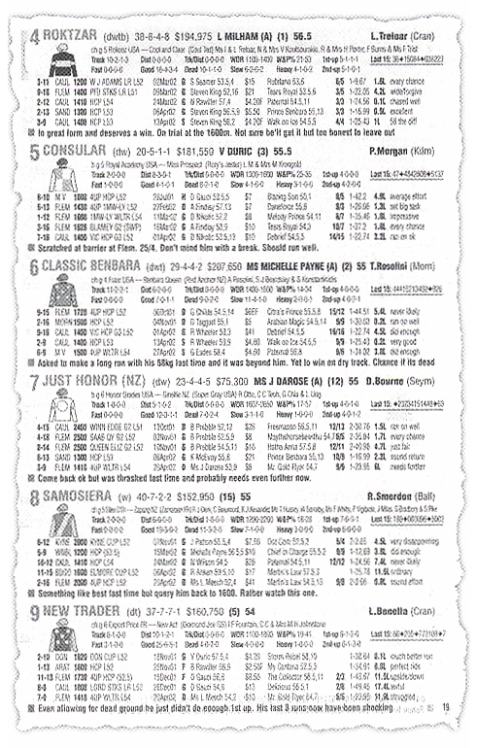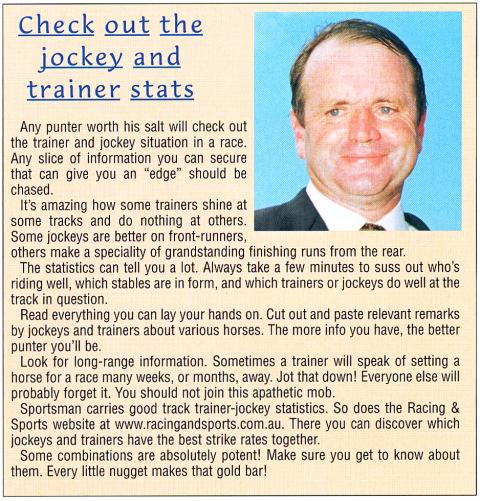Little snippets, that's what gets you the winners," an old friend told me many moons ago. This man believed in the power of information, and I know that it helped him become a winner, in a moderate way, at racing.
I've often thought of his words, and applied them to my own betting approach. You see, to my way of thinking, winning is all about making use of information. But what you must do is to look for the information that others might tend to ignore or just simply fail to see.
If you're prepared to look and learn, you can pick up all sorts of clues from what others write. Years ago, back in the late '70s, I picked up a system by a man called Frank George. What I learned from this system helped me create a winning system of my own.
Frank George's system applied to racing in the UK, but it was easily adaptable for Australia. Over the years, I've modified it slightly as things have changed here and currently it stands at the following set of rules:
- The horse must be a winner on the track in the same class or a lower class of race to the current one.
- The horse must be in the top three of Sportsman's Zipform ratings.
- The horse must be carrying the same weight or less than last start.
- The horse must have run a placing in last two runs.
- The distance of the current race must not be more than 200m either way from the horse's last start (up or down, that is).
- The horse must be in the first three in the betting, or on the first three lines of betting.
- The horse must be proven in the current track conditions.
So there you have it. A system I picked up in a street market in London and adapted for my own use. A nugget or two of information used to my advantage. And this is a darned good system, too.
On the Internet these days, it's easy to pick up good ideas from fellow punters. There are any number of newsgroups you can join. You don't have to contribute, just "lurk" and lap up the information provided by others.
The popular Smartsig group is an example. A discussion on "bouncing form" was raised recently and in the process of discussing it the members handed out various views on the factors they used in making their selections.
One chap wrote: "Younger horses with a mixture of 1's and 2's in the form show up as being best in the likelihood ratio tables, i.e. better win-strike rates, but the profitability of these is all around the 0.8 to 0.9 region, illustrating a clearly overbet area.
"Best profitability . . . is 5 and 6yo's with form figures around the 311, 312 area, but not excluding 313, 314, 310, etc."

Another member wrote: "The point about the improvement in profitability of horses who have disappointed last time out after running a good race on their penultimate outing is well worth serious consideration.
"It's a method I've used profitably over the years, particularly when there are valid excuses for the previous disappointing run."
This man's favourite angles were outlined as:
- Horse returning to a similar class to its good run following an unsuccessful attempt against better opposition.
- Horse running from a decent draw following a poor run from a poor draw last time out.
- Horse returning to the same distance or track condition after facing unsuitable conditions last start.
So there are some nuggets of information that you may be able to use to your advantage. They make sense to me.
As we've stated before in PPM, your formguide can contain many nuggets of information that can be turned into gold. Your task, as a punter, is to seek out the information and make use of it.
Let's take the average punter with a Best Bets formguide in his hand. How can he make it pay for him? I suggest that the comments next to the performance details of each horse are very useful indeed.
Best Bets calls them "video comments" and they're just one, two or three words that try to sum up and explain the horse's performance. I like to look for the really positive ones.
As an example, look at the winner Dark Wine in the third race at Moonee Valley on April 27. Each of its last three runs received most positive appraisals. They were SOUND EFFORT, then SOUND EFFORT, and for the 4yo mare's last start the comment was SOUND RETURN.
These comments made me alert to the fact that here was a horse who's put together three GOOD performances at her last three starts. I then began to note other characteristics. She was a winner at the track over the distance (2040m), she was drawn well, and I also noted that her last start, when she ran 5th, had been her first run for seven weeks.
Looking at a major race that day, the Wyndham Estate Cup over 1200m, at Doomben, I saw that Lord Essex had been receiving high praise in the Best Bets video comments. For the 5yo's last start, a win in the Group 1 George Ryder Stakes on March 16, the comment was EASY LEAD /DUG DEEP.
I underlined this comment because I was attracted by the "DUG DEEP" remark. This indicates a brand of courage in the horse. He won the Ryder by a nose from the very good type Shogun Lodge.
Of course, in any one race you will usually find a number of runners who have favourable comments next to their performances. There are, you see, many nuggets of information to be digested, appraised and decided upon. This is the nature of the betting game. Nothing is crystal clear, much is guesswork.

Looking further at Lord Essex, there were other aspects to its form that made appeal. He'd run six times at 1200m and won three of them, a 50 per cent strike rate, which was 9 per cent above his overall impressive enough strike rate of 41 per cent. He was in a strong stable, that of John Hawkes, and he had a talented jockey aboard and one with local knowledge, Scott Galloway.
Add to this the fact that Lord Essex tended to race well when fresh from a break (he'd had six weeks off) and you could start to deduce that here was a horse with a bold chance of putting himself into the frame. Which is what he did. He won at very good odds of around 8/1.
Going back to Moonee Valley, another winner could have been nailed with some astute observation of more nuggets of information. Lethal Leigh, in the final race, had raced only twice but each time had received the seal of approval, with the comments EXCELLENT DEBUT and HAD GOOD RUN. In the line accompanying the form, Best Bets also noted that he'd sat wide at Sandown last start and had "kept coming" to win over 1200m.
Other positive factors? He'd raced once at the trip for a win, his jockey was claiming 2kg to bring him on the Limit at 52kg, he was drawn well, and he was up against a fairly moderate field.
You would not have needed to have been a Sherlock Holmes to decide that Lethal Leigh had to be rated as a chance in the race.
The moral of this article, then, is to look more closely than you might normally do when looking at the form. And through the week, scan the newspapers for clues. Check out Internet racing sites for pointers. Mark them all down. Keep a notebook, or set up a file on your computer.
Do all you can to remember little things. Perhaps a trainer says something on TV about what he intends to do with a horse. Most people forget. You should ensure you remember. One tiny nugget of information can sometimes lead you to a 20/1 winner.
By Denton Jardine
PRACTICAL PUNTING - JUNE 2002